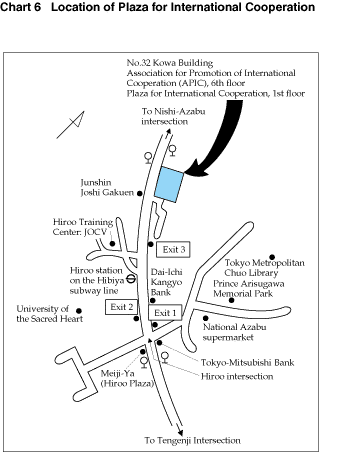Official Development Assistance (ODA)
13. Public Understanding
1. Disclosure and Public Relations
Disclosure is extremely important to the task of promoting public understanding of, support for, and participation in the nation's ODA programs. To that end, the government has been pursuing various efforts in disclosure and public relations.
- ODA White Paper entitled "Japan's ODA" (first published in 1984)
- Annual Evaluation Report on Japan's Economic Cooperation (first issued in 1982)
- Annual Report on Trends in Japanese ODA First issued in 1993, and provides an overview not only of MoFA-led ODA activities, but also the activities of other government ministries and agencies as well as the multilateral institutions to which Japan makes financial contributions.
- International Cooperation Day and International Cooperation Festival October 6 is International Cooperation Day. Various events have been held on that date nationwide since 1987.
- Plaza for International Cooperation Opened to the public in October 1993, the Plaza for International Cooperation facility is about a 3-minute walk from Hiroo Station on the Hibiya subway line in Tokyo. It is run by the Association for Promotion of International Cooperation. The plaza is currently working to expand its regional network. As of September 1998, it had opened 17 Plaza for International Cooperation Corners in various localities.
2. Public Relations Activities Overseas
Japan also utilizes the opportunities afforded by overseas survey missions and signing ceremonies for various ODA-related public relations activities abroad, including project study tours for government agencies and press organizations in the developing world. It also distributes PR pamphlets in several local languages. MoFA's web site incorporates an English home page for the disclosure of information on core Japanese ODA policies and programs. Visitors to the page have access to ODA summaries and abridged project evaluation reports. Additional information of a PR nature is offered through the local-language web sites maintained by Japanese embassies and other diplomatic offices abroad. Incidentally, Japanese emergency aid supplies and other ODA-funded equipment and supplies are adorned with the official Japanese ODA logo (also on the back cover of this document, in the upper left corner).
3. Development Education and the Training of Aid Personnel
To foster better public awareness and understanding of the economic, environmental, and other issues that many developing countries face, and accordingly earn public acceptance of the value of aid, it seems essential that the Japanese education system accurately portray the significance of ODA and current realities in the development assistance field.
However, in a report concerned with administrative supervision, the Administrative Management and Coordination Agency concluded that school textbooks do not yet present an accurate picture of ODA. MoFA, JICA, and the OECF have begun taking steps to provide accurate information to educators and students by mailing copies of the ODA White Paper to school textbook writers, conducting development education seminars at the community level, supplying schools with instructional materials and PR-oriented videos, and holding university lectures and debates in the form of ODA teach-ins. 29
However, to fulfill its role as a leading donor in the years ahead, Japan will nonetheless face the crucial task of training more professionals for service in the development assistance field. The Foundation for Advanced Studies on International Development (FASID) was established largely for that purpose in March 1990. FASID now plays a central role in development education and research at the graduate and postgraduate levels. It is involved in an array of undertakings, ranging from development assistance training programs and the sponsorship of international symposia to the implementation of development-related surveys and research.

